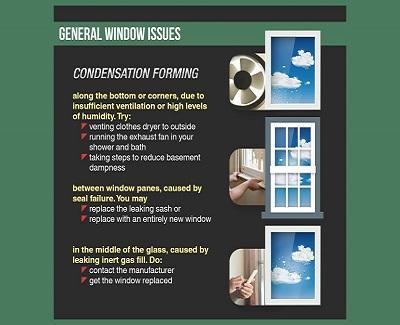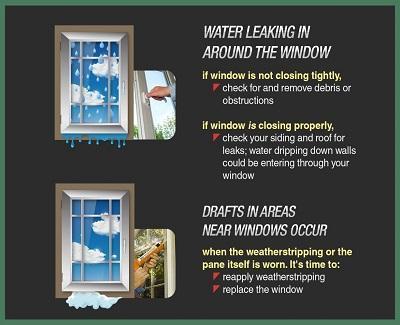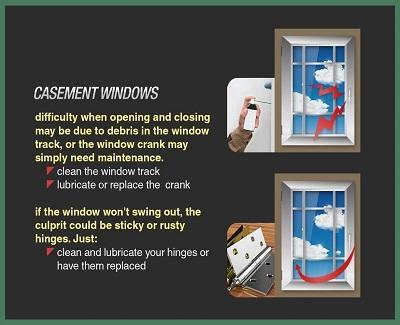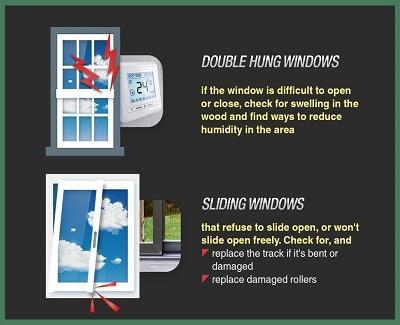Problems with your windows are a cause for concern: anything that affects your windows can, and will, lead to other problems if left unchecked. Many of these issues have similar signs and symptoms which can hamper your attempts to resolve the issue. Once you’ve identified the root of the problem, however, solutions are pretty straightforward. Here’s a handy visual guide to help you identify and solve your window problems.
Condensation
Condensation in and around the window is a major sign that you have a problem somewhere; how and where the condensation forms will tell you what the problem is, and how to go about resolving it.

If you have condensation forming along the bottom or corners of your windows, then the problem isn’t actually with the window; rather, it’s a sign that you have too much humidity in the room, and insufficient ventilation. Check to make sure appliances like clothes dryers are venting to the outside of your home, and make sure to always run the exhaust fan in your shower and bath. You should also check your basement and take steps to reduce dampness there.
If the condensation is forming between the window panes then your window seals are either in the process of failing, or have failed entirely. This means the window is letting in outside air, which in turn allows moisture to get trapped between the window panes. With newer, more recently-installed windows it should be sufficient to replace the leaking window sash, but for an older window your best bet might be to replace the window entirely.
If the condensation is forming in the middle of the glass, on the side inside the house, then the inert gas fill in your multi-pane windows has leaked out. If your windows are still under warranty, contact the manufacturer. Otherwise, the window will need to be replaced.
Water leaking

Water leaking in around the window is most commonly caused by the window not closing tightly. Check for rain water, debris, and other obstructions along the frame and window track, and see if the window will then close and lock properly.
If, however, the window is operating properly, and the water is leaking in along the top of the window, then the problem is not with the window; rather, you have a leak somewhere, either in the siding or on the roof. The water from the leak is dripping down the wall and entering through the window.
Drafty areas near the window
If you’re noticing a draft near the window, then you have a problem either with the window panes or the weatherstripping around them. If you notice that the weatherstripping is peeling or has chunks missing from it altogether, then all you need to do is replace the weatherstripping. If the weatherstripping is otherwise fine, however, then that’s a sign that you need to replace the window.
Style-specific problems
Some problems are more or less specific to certain types or styles of windows.
Bay and bow windows, because of their size and weight, can sag and render the windows inoperable. If the windows are no longer covered by warranty, then your only real option is to add support to the window. The window will first need to be elevated, typically by using a hydraulic jack at each corner. Once the window has been elevated properly, support brackets can be added at the top of the window to keep the window elevated, and the jacks may then be removed.
Casement windows can often become difficult to open and close. The most common causes for this are obstructions in the window track, or the problem may be with the window crank. Check the window track for dirt and debris and clean out the track. If that still doesn’t solve the problem, try lubricating the crank. If all else fails, replace the crank.

If your problem is that the window won’t swing out all the way, your most likely culprit is sticky or rusty hinges. Depending on the state of the hinges, it might be possible to just clean and lubricate them, but if the problem won’t go away after, you may need to replace the hinges.
With double-hung windows, the most common problem you’ll encounter is the window being difficult to open and close, or the window sticking altogether. If this is the case, check the window frame and sashes to see if the wood is swelling; swelling is an indication that you have too much humidity in the area, and that moisture is being absorbed into the wood.

Owners of sliding windows may find that their windows are refusing to slide open, or will not slide open freely. In this case, the problem will most likely be with the window track. Clean the track and remove any debris that might be hampering the window’s operation, then check the track and rollers for damage. In case of damage to either the track or rollers, having them replaced should solve the problem.
============================================================
Author Bio:
Dawn Dewey is one of Professional Remodeler magazine’s “40 under 40” for the year 2015 and, as marketing director of Renewal by Andersen of Boise, is responsible for spreading the company’s name far and wide. In addition to home improvement, she has a passion for animal welfare, the environment, and civil rights.
============================================================
